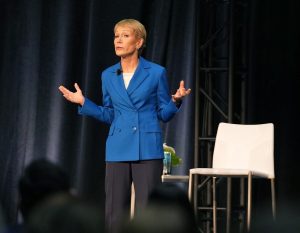Tips for Success, Office Sector Snapshots: CRE.Converge Highlights
Expert insights on a wide range of trends from NAIOP's annual conference.
Can you build a business through a crisis and still come out on top? Barbara Corcoran, the real estate mogul behind The Corcoran Group and star of “Shark Tank,” has survived three recessions and knows the ins and outs of weathering the storm.
At NAIOP’s CRE.Converge last week in Seattle, she shared some lessons she’s learned along the way:
- Perception creates reality.
- There are only two kinds of people at work: Expanders (who excel at sales, publicity and other public-facing activities) and Containers (who thrive with personnel management, organization and other internal-focused tasks).
- Hire happy people.
- Fun is good for business.
- Recognition motivates more than money.
- Be good at failure.
- Bad times are the best times to move ahead.
Other highlights from the conference:
- Low occupancy across the office sector and high demand for housing are causing many real estate development professionals to ask whether adaptive reuse of commercial buildings could be a way to add supply. Mark Taylor, residential managing director at American Real Estate Partners, said these projects work only if the property is in a strong location. “At the end of the day, is the building located somewhere where people want to live, and will they pay a premium rent to live there? Because if you’re not in a submarket where you’re not getting at least $3 a foot in rent, you’re not doing an adaptive reuse.”
READ ALSO: What’s Next for Office?
- Several major corporations, such as Roblox and Nike, have recently called back workers to the office or increased the number of required office days. On the sales side, while the market had been frozen on the West Coast for months, activity is picking up again, particularly in San Francisco.
- Mass timber has a bright future in development but developers and builders must learn about and overcome some major hurdles. An engineered wood product typically made of large panels or beams that are manufactured off-site, mass timber products are engineered to bear weight like steel or concrete but are of lighter weight. Because it is lighter and prefabricated, it can cut down on construction times and reduce labor costs. The product is also considered more environmentally friendly. However, there are obstacles for the widespread adoption of mass timber, including supply-side issues, local codes and, occasionally, fear of the unknown.
- High interest rates combined with persistent inflation have created the toughest commercial real estate financing environment since the Global Financial Crisis.
“What we have to do as an industry is get used to the pricing of debt as it exists today, and play ball that way,” said Al Pontius, national director, office & industrial division, Marcus & Millichap. The continued anticipation of dropping interest rates takes out a lot of players. Pontius said he wants buyers and sellers to get away from the idea that there’s no price discovery, and instead consider alternatives, such as holding off as a buyer. More importantly, the office commercial real estate landscape should be discussed asset-by-asset rather than treated with a universal prescription.
While some aspects of the industry are certainly struggling, others are thriving. And the mood of the conference reflected what Corcoran said in her opening keynote:
“[Real estate] always comes back,” Corcoran said. That’s the beauty of our business. But it’s about what you do while you’re waiting for it to come back.”
Read session recaps from many of the conference programs.








You must be logged in to post a comment.